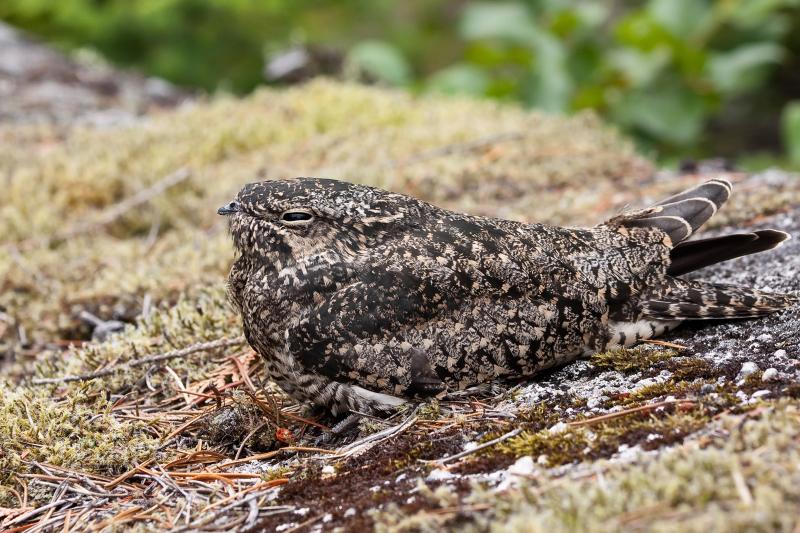Seen Any Nighthawks Lately?
 Common nighthawks are amazing fliers. They catch all their insect prey in flight, and they migrate from wintering grounds in southern South America to breeding grounds across the U.S. and Canada. Photo courtesy of National Park Service/Jacob W. Frank via Wikimedia Commons.
Common nighthawks are amazing fliers. They catch all their insect prey in flight, and they migrate from wintering grounds in southern South America to breeding grounds across the U.S. and Canada. Photo courtesy of National Park Service/Jacob W. Frank via Wikimedia Commons.
 It’s only a lucky few that ever spot a common nighthawk on the ground, where their cryptic plumage makes them incredibly difficult to find. Photo by Gavin Keefe Schaefer courtesy of Wikimedia Commons.
It’s only a lucky few that ever spot a common nighthawk on the ground, where their cryptic plumage makes them incredibly difficult to find. Photo by Gavin Keefe Schaefer courtesy of Wikimedia Commons.
 Common nighthawks are amazing fliers. They catch all their insect prey in flight, and they migrate from wintering grounds in southern South America to breeding grounds across the U.S. and Canada. Photo courtesy of National Park Service/Jacob W. Frank via Wikimedia Commons.
Common nighthawks are amazing fliers. They catch all their insect prey in flight, and they migrate from wintering grounds in southern South America to breeding grounds across the U.S. and Canada. Photo courtesy of National Park Service/Jacob W. Frank via Wikimedia Commons.
 It’s only a lucky few that ever spot a common nighthawk on the ground, where their cryptic plumage makes them incredibly difficult to find. Photo by Gavin Keefe Schaefer courtesy of Wikimedia Commons.
It’s only a lucky few that ever spot a common nighthawk on the ground, where their cryptic plumage makes them incredibly difficult to find. Photo by Gavin Keefe Schaefer courtesy of Wikimedia Commons.
There is something captivating about the common nighthawk, a bird whose wings seem to cut the air like small swords as it flies silently overhead. A bird seen only just before dark and in flight, its daytime whereabouts rarely known.
Here in Maine, common nighthawks are a sign of late summer when small groups begin appearing in the startlingly blue skies of lazy August evenings. In those final days of summer, just before the kids are off to school again and everyone seems desperate to fit in a few more swims in the lake, birders look and see them. Dark, sharp-winged birds the size and shape of small falcons swooping rapidly back and forth with sudden quick shifts of direction.
And then a few minutes later, they disappear, moved on in their relentless migratory drive to be away from the cold weather yet to come.
Nighthawks could never survive a winter in the north. They live off insects that they catch on the wing.
New migration tracking research has shown that the routes of common nighthawks from across their North American breeding range coalesce into a corridor through Colombia on their way to wintering grounds even farther south, mostly in Brazil. Thousands of them pass through Maine from Canada on their way south each fall.
Years ago, birders regularly reported seeing hundreds in single large flocks, but today, it’s more common to see groups of ten or twenty. In fact, common nighthawks are thought to have declined by nearly 50% across their range since 1966.
This year some birders have reported seeing groups of migrating nighthawks flying high overhead and straight ahead instead of darting about, closer to the ground. The birds seemed as if they were trying to move through as quickly as possible without stopping to feed. Others have reported seeing nighthawks behaving more typically. The relatively few nighthawks we have seen this fall (so far) have disappeared quickly, and we haven’t seen any over our house. This is unusual.
We have wondered whether the drought in southern Maine has had any impact on the insect populations that nighthawks feed on as they migrate through. It’s anecdotal, but we have noticed very few hatches of flying ants this late summer and early fall. We have written in the past about our conjecture that nighthawks may time their fall migration to take advantage of the hatches of flying ants as an abundant food source. Is it possible that the drought and heat have impact the number or timing of such hatches? If so, could that affect the migratory behavior of nighthawks?
Fortunately, these captivating birds are receiving more and more attention by scientists. Hopefully more of these questions will be answered as more research results are published in the coming years.
Birders are still seeing nighthawks across much of the state even in the last few days, so perhaps more will be coming through. Keep your eyes to the skies!
Jeffrey V. Wells, Ph.D., is a Fellow of the Cornell Lab of Ornithology and Vice President of Boreal Conservation for National Audubon. Dr. Wells is one of the nation's leading bird experts and conservation biologists and author of the “Birder’s Conservation Handbook.” His grandfather, the late John Chase, was a columnist for the Boothbay Register for many years. Allison Childs Wells, formerly of the Cornell Lab of Ornithology, is a senior director at the Natural Resources Council of Maine, a nonprofit membership organization working statewide to protect the nature of Maine. Both are widely published natural history writers and are the authors of the popular books, “Maine’s Favorite Birds” (Tilbury House) and “Birds of Aruba, Bonaire, and Curaçao: A Site and Field Guide,” (Cornell University Press).






















